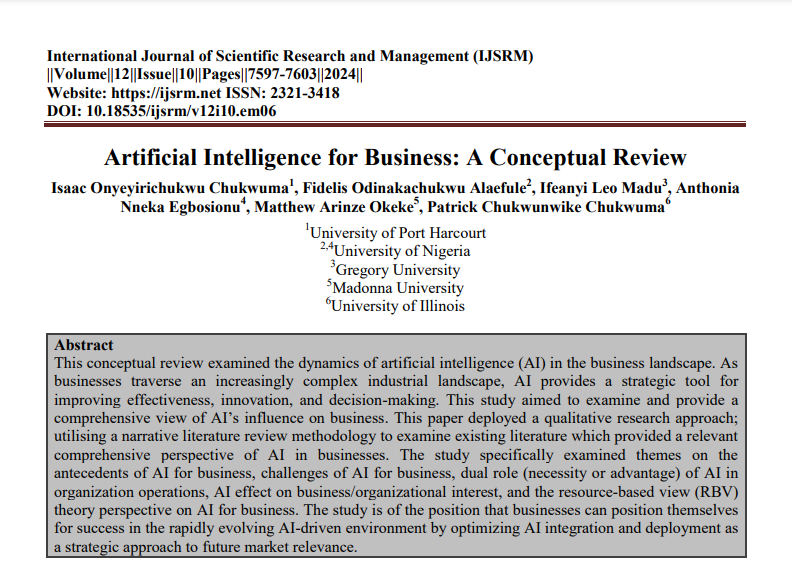
Submission to VIJ 2024-10-03
Keywords
- Artificial Intelligence,
- Resource-based view theory
Copyright (c) 2024 Isaac Onyeyirichukwu Chukwuma, Fidelis Odinakachukwu Alaefule, Ifeanyi Leo Madu, Anthonia Nneka Egbosionu, Matthew Arinze Okeke, Patrick Chukwunwike Chukwuma

This work is licensed under a Creative Commons Attribution 4.0 International License.
Abstract
This conceptual review examined the dynamics of artificial intelligence (AI) in the business landscape. As businesses traverse an increasingly complex industrial landscape, AI provides a strategic tool for improving effectiveness, innovation, and decision-making. This study aimed to examine and provide a comprehensive view of AI’s influence on business. This paper deployed a qualitative research approach; utilising a narrative literature review methodology to examine existing literature which provided a relevant comprehensive perspective of AI in businesses. The study specifically examined themes on the antecedents of AI for business, challenges of AI for business, dual role (necessity or advantage) of AI in organization operations, AI effect on business/organizational interest, and the resource-based view (RBV) theory perspective on AI for business. The study is of the position that businesses can position themselves for success in the rapidly evolving AI-driven environment by optimizing AI integration and deployment as a strategic approach to future market relevance.
References
- Barney, J. (1991). Firm Resources and Sustained Competitive Advantage. Journal of Management, 17(1), 99-120.
- Bessen, J. E. (2018). AI and Jobs: The Role of Demand. NBER Working Paper No. 24235. Retrieved from NBER
- Brynjolfsson, E., & McAfee, A. (2014). The Second Machine Age: Work, Progress, and Prosperity in a Time of Brilliant Technologies. W.W. Norton & Company.
- Budhwar, P., Malik, A., Thedushika-De-Silva, M. T., & Thevisuthan, P. (2022). Artificial intelligence – challenges and opportunities for international HRM: A review and research agenda. The International Journal of Human Resource Management, 33(6), 1065-1097.
- Chui, M., Manyika, J., Miremadi, M., Henke, N., Chung, R., Nel, P., & Machotra, S. (2018). Notes from the AI frontier: Insights from hundreds of use cases. McKinsey Global Institute. Retrieved from McKinsey
- Cockburn, I. M., Henderson, R., & Stern, S. (2018). The Impact of Artificial Intelligence on Innovation. NBER Working Paper No. 24449. Retrieved from NBER
- Davenport, T. H., Harris, J. G., & Morison, R. (2010). Analytics at Work: Smarter Decisions, Better Results. Harvard Business Review Press.
- Davenport, T. H., & Patil, D. J. (2012). Data Scientist: The Sexiest Job of the 21st Century. Harvard Business Review. Retrieved from Harvard Business Review
- Davenport, T. H. (2018). Artificial Intelligence for the Real World. Harvard Business Review. Retrieved from Harvard Business Review
- European Commission. (2018). Artificial Intelligence for Europe. Communication from the Commission to the European Parliament, the Council, the European Economic and Social Committee, and the Committee of the Regions. Retrieved from European Commission
- European Commission. (2021). Proposal for a Regulation of the European Parliament and of the Council on Laying Down Harmonized Rules on Artificial Intelligence. Retrieved from European Commission
- Floridi, L., Cowls, J., Beltrametti, M., Chatile, R., Chazerand, P., Dignum, V., Luetge, C., Madelin, R., Pagallo, U., Rossi, F., Schafer, B., Valcke, P., & Vayena, E. (2018). AI4People - An Ethical Framework for a Good AI Society: Opportunities, Risks, Principles, and Recommendations. Minds and Machines, 28, 689-707.
- Manyika, J., Chui, M., Brown, B., Bughin, J., Dobbs, B., Roxburgh, C., & Byers, A. H. (2011). Big Data: The Next Frontier for Innovation, Competition, and Productivity. McKinsey Global Institute. Retrieved from McKinsey.
- Goodfellow, I., Shlens, J., & Szegedy, C. (2015). Explaining and Harnessing Adversarial Examples. In Proceedings of the 2015 International Conference on Learning Representations (ICLR 2015). Retrieved from arXiv.org
- Huang, M. H., & Rust, R. T. (2018). Artificial Intelligence in Service. Journal of Service Research, 21, 155-172.
- Jarrahi, M. H. (2018). Artificial intelligence and the future of work: Human-AI symbiosis in organizational decision making. Business Horizons, 61(4), 577-586.
- Jordan, M. I., & Mitchell, T. M. (2015). Machine Learning: Trends, Perspectives, and Prospects. Science, 349, 255-260.
- Kotter, J. P. (1996). Leading Change. Harvard Business Review Press.
- Krizhevsky, A., Sutskever, I., & Hinton, G. E. (2012). ImageNet Classification with Deep Convolutional Neural Networks. In Advances in Neural Information Processing Systems (NeurIPS 2012), 1097-1105.
- LeCun, Y., Bengio, Y., & Hinton, G. (2015). Deep Learning. Nature, 521(7553), 436-444.
- Lipton, Z. C. (2016). The Mythos of Model Interpretability. Communications of the ACM, 61(10), 36-43.
- Manyika, J., Chui, M., Miremadi, M., Bughin, J., George, K., Willmott, P., & Dewhurst, M. (2017). A Future That Works: Automation, Employment, and Productivity. McKinsey Global Institute. Retrieved from McKinsey.
- Mayer-Schönberger, V., & Cukier, K. (2014). Big Data: A Revolution That Will Transform How We Live, Work, and Think. Harper Business Publishers.
- O'Neil, C. (2016). Weapons of Math Destruction: How Big Data Increases Inequality and Threatens Democracy. Crown Publishing Group.
- Pang, B., & Lee, L. (2008). Opinion mining and sentiment analysis. Foundations and Trends® in Information Retrieval, 2(1–2), 1-148.
- Resnik, D. B., & Hosseini, M. (2024). The ethics of using artificial intelligence in scientific research: New guidance needed for a new tool. AI and Ethics, 1-23.
- Russakovsky, O., Deng, J., Su, H., & Li, L. J. (2015). ImageNet Large Scale Visual Recognition Challenge. International Journal of Computer Vision, 115, 211-252.
- Russell, S., & Norvig, P. (2020). Artificial Intelligence: A Modern Approach (4th ed.). Pearson.
- Szegedy, C., Zaremba, W., Sutskever, I., runa, J., Erhan, D., Goodfellow, I., & Fergus, R. (2013). Intriguing Properties of Neural Networks. Retrieved from arXiv.org
- Teece, D. J., Pisano, G., & Shuen, A. (1997). Dynamic Capabilities and Strategic Management. Strategic Management Journal, 18(7), 509-533.
- Voigt, P., & Von dem Bussche, A. (2017). The EU general data protection regulation (GDPR): A practical guide. 1st Ed., Springer International Publishing